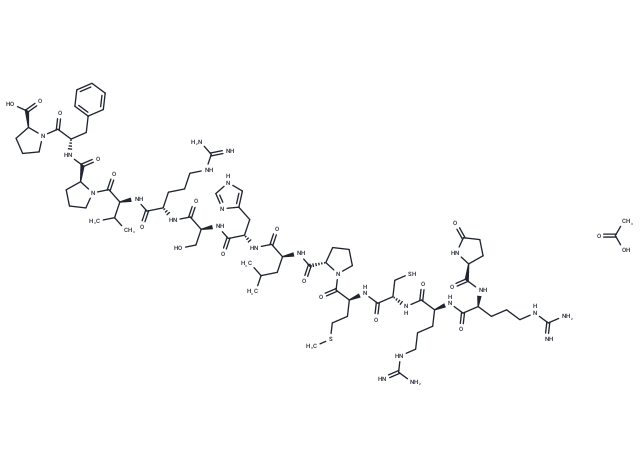Shopping Cart
- Remove All
 Your shopping cart is currently empty
Your shopping cart is currently empty

ELA-14(human) acetate is a fragment of ELA that binds to APJ, activates the Gαi1 and β-arrestin-2 signaling pathways, and induces receptor internalization similarly to its parent endogenous peptide.

| Pack Size | Price | Availability | Quantity |
|---|---|---|---|
| 1 mg | $57 | In Stock | |
| 5 mg | $213 | In Stock | |
| 10 mg | $320 | In Stock | |
| 25 mg | $518 | In Stock | |
| 50 mg | $713 | In Stock | |
| 100 mg | $948 | In Stock | |
| 200 mg | $1,270 | In Stock |
| Description | ELA-14(human) acetate is a fragment of ELA that binds to APJ, activates the Gαi1 and β-arrestin-2 signaling pathways, and induces receptor internalization similarly to its parent endogenous peptide. |
| Targets&IC50 | β-arrestin2:166 nM(EC50), Gαi1:8.6 nM(EC50) |
| In vitro | ELA-14 activates the Gαi1 and β-arrestin-2 signaling pathways with EC50s of 8.6 nM and 166 nM. ELA-14 induces receptor internalization and reduces arterial pressure, exerts positive inotropic effects on the heart[1]. |
| In vivo | ELA-14 is rapidly metabolized in rat plasma (t1/2<2 min)[1]. |
| Alias | ELA-14(human) acetate (1886973-05-2 free base) |
| Molecular Weight | 1767.09 |
| Formula | C77H123N25O19S2 |
| Smiles | CC(C)C[C@@H](C(N[C@@H](Cc1c[nH]cn1)C(N[C@@H](CO)C(N[C@@H](CCCNC(N)=N)C(N[C@@H](C(C)C)C(N(CCC1)[C@@H]1C(N[C@@H](Cc1ccccc1)C(N(CCC1)[C@@H]1C(O)=O)=O)=O)=O)=O)=O)=O)=O)NC([C@H](CCC1)N1C([C@H](CCSC)NC([C@H](CS)NC([C@H](CCCNC(N)=N)NC([C@H](CCCNC(N)=N)NC([C@H](CC1)NC1=O)=O)=O)=O)=O)=O)=O.CC(O)=O |
| Relative Density. | no data available |
| Storage | keep away from moisture | Powder: -20°C for 3 years | In solvent: -80°C for 1 year | Shipping with blue ice. | ||||||||||||||||||||||||||||||
| Solubility Information | H2O: 100 mg/ml (56.59 mM), Sonication is recommended. | ||||||||||||||||||||||||||||||
Solution Preparation Table | |||||||||||||||||||||||||||||||
H2O
| |||||||||||||||||||||||||||||||

Copyright © 2015-2025 TargetMol Chemicals Inc. All Rights Reserved.